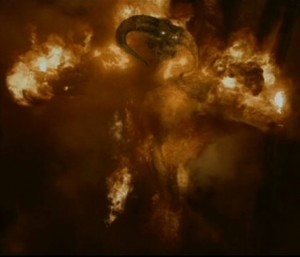I can’t believe I missed this Jess Nevins piece over on No Fear of the Future talking about 19th century SF writer and astronomer Camille Flammarion (I have a couple of first English-language translations of his work) scheme to avert war by having all the armies of Europe dig a giant hole in the ground. This probably wasn’t the wackiest naive pacifist scheme to avert war in the 19th century (though it is even wackier than, say, teaching everyone to speak Esperanto; see Howard Waldrop’s story “Ninieslando” for more details on how that worked out…)
But I’m also fascinated by the Hollow Earth theories propounded by John Cleves Symmes, Jr., who in 1818 proclaimed:
I declare the earth is hollow and habitable within; containing a number of solid concentric spheres, one within the other, and that it is open at the poles 12 or 16 degrees; I pledge my life in support of this truth, and am ready to explore the hollow, if the world will support and aid me in the undertaking.

As wacky cosmological theories, this one had a lot going for it (and certainly more than, say, the theories of Immanuel Velikovsky). For one thing, given the state of exploration and geology extent in 1818, it wasn’t clearly wrong. For another, the idea of internal worlds, of delving deep into the earth, has always fascinated mankind, from the Greek and Sumerian underworlds all the way up through The Mines of Moria, Dungeons and Dragons, and even Minecraft. (Not to mention those Denver airport and Dulce base conspiracy theories.)
Symmes theories even inspired a novel. (Note: The person who put up that e-text of Symzonia says even reprints are rare, but this is no longer the case, as Amazon and Bookfinder are lousy with POD editions.) And Edgar Allen Poe would use some of Symmes’ ideas in The Narrative of Arthur Gordon Pym.
Another permutation of the Hollow Earth idea was Richard Shaver’s Shaver Mystery. Shaver claimed to hear voices in his head while using welding equipment, and claimed that “detrimental robots” (or deros) lived inside the earth and beamed mind control rays at the surface dwellers. For a while Amazing publisher Ray Palmer had every crackpot in America writing letters to add to the mystery in the late 1940s, just when when the first wave of flying saucer mania was reaching its peak.
Edgar Rice Burroughs’ Pellucidar series is set in the Hollow Earth, and an ever-growing number of science fiction writers have taken advantage of the idea, from Howard Waldrop and Steve Utley’s “Black as the Pit, from Pole to Pole” to Rudy Rucker’s The Hollow Earth, which also features Poe.
Believe it or not, there are some who still believe in the Hollow Earth theory. (Of course, there are still people who believe in a flat earth as well. And they’re looking for new believers once again!)
For more information, I would suggest looking up Walter Kafton-Minkel’s Subterranean Worlds, but since Loompanics Press went out of business (the people currently using their website just picked up the domain name when it lapsed), it’s gotten a bit pricey. I have David Standish’s Hollow Earth: The Long and Curious History of Imagining Strange Lands, Fantastical Creatures, Advanced Civilizations, and Marvelous Machines Below the Earth’s Surface, but I haven’t read it yet.
Tags: Camille Flammarion, Conspiracy Theories, Denver Airport, dero, Edgar Allen Poe, Flat Earth, fringe science, Hollow Earth, Howard Waldrop, Immanuel Velikovsky, John Cleves Symmes, Minecraft, Walter Kafton-Minkel

Where did you receive the information that Esperanto is a “whacky idea” ?
After a short period of 123 years Esperanto is now in the top 100 languages, out of 6,800 worldwide, according to the CIA factbook. It is the 22nd most used language in Wikipedia, and a language choice of Google, Skype, Firefox, WordPress and Facebook.
Native Esperanto speakers,(people who have used the language from birth), include World Chess Champion Susan Polger, Ulrich Brandenberg the new German Ambassador to NATO and Nobel Laureate Daniel Bovet.
Further arguments can be seen at http://uk.youtube.com/watch?v=_YHALnLV9XU Professor Piron was a translator with the United Nations in Geneva.
A glimpse of Esperanto can be seen at http://www.lernu.net or at http://eurotalk.com/en/store/learn/esperanto
Without speaking for Lawrence, the implication I picked up was less that Esperanto itself was a wacky idea, and more that thinking a world where everyone spoke the same language would be completely devoid of war other conflict and the lions would be lying down with the lambs and everyone would be holding hands and singing “The Internationale” was a wacky idea.
Whew.
That implication is pretty obvious to me. but all my responses were A LOT more snarky.